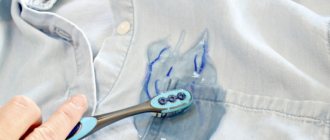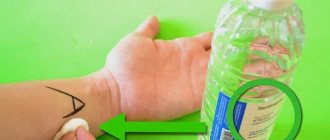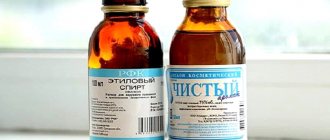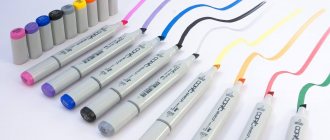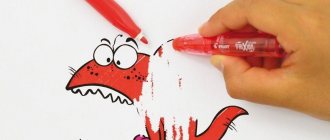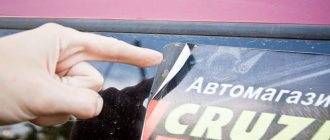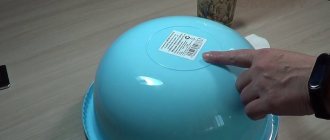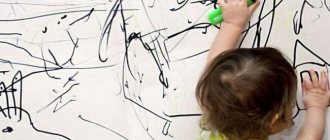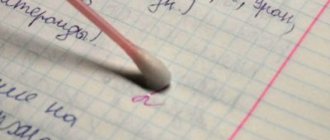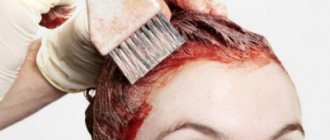What is this text about? In this text we will answer the following questions: how to remove putty from paper how to remove putty from a notebook how to remove a line from paper how to remove corrector from clothes in a simple way.
A proofreader for correcting mistakes written or printed on paper is, in common parlance, a touch that is one of the most important office tools in our time. Everyone uses it: schoolchildren and office workers, workers and employees in various fields of activity. Trouble in the form of a stain from a stroke on clothing awaits anyone. How to remove correction fluid from clothes, how to wipe off a touch from your favorite thing?
Removing water-based concealer
Water strokes are the most common. They are odorless, non-toxic and non-flammable. They are afraid of low temperatures and take a long time to dry. Easy to wash as they dissolve with water.
- You need to wait until the putty dries.
- Then, with a light movement so as not to damage the fabric, scrape off the dried concealer using a toothbrush, nail file, or knife
remove the top layer of concealer using improvised means
- After this, soap the stain. You can use Laundry or any other soap, as well as dishwashing detergent or any shampoo.
- Then use a wet sponge to rinse off in a circular motion.
Using rotational movements, we wash off the remnants of the streak from the clothes.
- If the item can be washed completely, then perform the previous operations before washing.
How to remove putty from leather shoes?
First, a clean item must be treated with a solvent. You can even use kerosene or acetone. The stain is soaked in the composition and left for about 20 minutes. If you have stained yourself with sealing liquid and don’t know how to remove it, you should not think that this stain will remain on your things or table for the entire time.
Interesting materials:
How to change UEFI on Legacy Dell? How to change device in Google? How to change notification sound on Samsung a50? How to place an object in the background in Photoshop? How to wash a cushion? How to wash split leather shoes? How to wash windows until they shine? How to understand aldehydic aroma? How to understand that Facebook is linked to Instagram? How can you tell if he still loves his ex?
Dry, tape correctors
To remove the stain from the dry tape corrector, we will again use the old scheme. It's simple:
- Wet the corrector layer with water or soapy water, or apply a damp cloth. Let's wait a little and then separate the tape from the clothing.
You need to blot the corrector tape and wait until it gets wet
- If water is not at hand, a nail file or a knife with a thin blade will do. Use them to scrape off the top layer of the tape.
- The final cleaning phase, as in other cases, is local or complete washing of the item by hand or in the washing machine.
How to wash streaks from the skin of your hands
To wash water-based hand concealer, you need:
- Wash them well with warm water and soap. To enhance the cleaning effect, rub the skin with a sponge or washcloth.
- You can get rid of contaminants from other types of strokes using alcohol or a solution containing alcohol: vodka or cologne.
- As one way, try applying a layer of toothpaste to the skin, and lightly rubbing it in, trying to first dissolve and then cleanse the white paste.
- After the procedure, wash your hands well with warm water and lubricate them with moisturizer.
Universal recipes
Dealing with stains on paper is difficult, since the material itself in most cases does not tolerate contact with any liquids well. The choice of product largely depends on what exactly the sheet was stained with. However, there are also universal substances that can cope with various types of pollution. Top 5 effective recipes:
Hydrogen peroxide .
With its help, you can not only remove, but also discolor the stain. For treatment, you can use pharmacy peroxide, or purchase 2 tablets of hydroperite, which are dissolved in 50 ml of warm water. Soak a cotton swab in the liquid and carefully work it over the contaminated surface on both sides.A blank sheet of paper is placed on top and bottom so that the document appears to be sandwiched between them. Once dry, the stains will disappear.
- Whitening toothpaste . It perfectly absorbs dirt and discolors the pigment, which makes the stain on the paper especially noticeable. The paste is applied with a brush in a thin layer and distributed evenly over the surface. After 1-2 minutes, remove it with a cotton pad and allow the sheet to dry. If the contamination cannot be removed the first time, the procedure is repeated.
- Refined gasoline . It acts as a solvent so it can easily remove most types of stains. The only condition is to process only paper that does not crumble when in contact with liquid. Gasoline is applied to a cotton pad, which is carefully passed over the entire surface of the stain. If after cleaning there is a greasy mark left on it, it should be sprinkled with starch and left overnight. In the morning the powder is cleaned off.
- Acetone. When processing paper, it is better to use nail polish remover, since the concentration of acetone in it is minimal. It is applied to the dirty mark with a brush, left for 2-3 minutes, wiped with a damp cotton pad and left to dry.
- Vinegar 9% . Acid can deal with many organic and inorganic types of stains. It can be used diluted or pure. It all depends on the intensity of pollution. Vinegar is applied to a cotton pad, applied to a dry sheet for 10 seconds and lifted. If the trace disappears immediately, then stop processing. There is no need to wash off the vinegar; it will dry and disappear on its own.
The video will show you how to remove dirt from paper using hydrogen peroxide:
Oil-based correction fluid.
Rarely found, made on an oil or emulsion basis. It has the positive properties of water and alcohol putty: it dries quickly, does not smell, does not burn, does not freeze. It is resistant to abrasion, so it is difficult to remove. To get rid of such a drug, we use the same means that it consists of, namely solvents:
- Ammonia
- White Spirit
- Solvent 647.646
- Acetone or nail polish remover
- Kerosene
- Petrol
- WD-40 (white spirit based aerosol)
remove the oil-based corrector.
Soak the damaged area with one of the products given above. For better interaction, cover with a cotton swab or a clean rag soaked in the dissolving solution. Let it stand for 10-15 minutes.
Then remove the dirt with a clean, dry cloth. At the end of the procedure, blot with a dry cloth. To consolidate the result, you can wash the item of clothing.
Use the popular WD-40 spray. Simply treat the stain and then wash with soap and water.
Lettering with gel pen
Writing with a gel pen is a difficult type of writing. Therefore, before you figure out how to erase a gel pen from paper, it is better to try the action on the same sheet of paper.
Ethyl alcohol
- You can remove ink from a gel pen with ethyl alcohol and baking soda. To prepare the mixture, mix 40 g of ethyl alcohol, 2 g of soda and 20 g of water. A sheet of paper is treated with this composition until unnecessary text written with a ballpoint pen is removed.
- You can erase a gel pen from paper without leaving a trace with a mixture prepared by combining ethyl alcohol and warm glycerin. Before removing the paste from the ballpoint pen, all ingredients are combined in equal parts. It is advisable to apply this mixture using a toothpick, accurately following the contours of the text being removed.
Starch
Mix equal parts potato starch and warm water in a mug. Apply this paste to the desired location and leave until dry. Then remove the starch with a dry sponge. The ink should be absorbed into the starch.
Alcohol-based touch-up corrector.
This type does not freeze, dries quickly, has a strong odor and can ignite. Removing concealer from clothes is more difficult, but it is possible.
- As in the case of a water corrector, wait until the correction emulsion dries
- Then scrape off the top layer
- To wash off the remnants of the stroke, use alcohol, or any alcohol-based solution:
- Vodka,
- formic alcohol,
- ammonia,
- solvent,
- You can take aftershave lotion or cologne.
- It is better not to use perfume, as it contains little alcohol.
Alcohol-based corrector removers from clothes
- We will treat the area around the stain with water so that the putty does not spread further during treatment.
- Wet the stain with one of the products listed above.
- Using a cotton swab or swab, carefully remove any remaining dirt.
- Wipe with a clean cloth.
- If possible, wash the item completely or partially after such treatment.
Features of removing different types of contaminants
The choice of cleaning agent is largely determined by what specific substance caused the stain on the paper. For example, to remove oil traces, you first need to absorb fat, and in the fight against smudges from watercolor paints, the splitting of the color pigment comes to the fore.
How to remove oil traces?
You can get rid of oil marks on paper using such compounds and improvised means as:
Bread crumb . Roll the crumb of white bread into a small ball, lightly moisten it with warm water and wipe the contaminated surface with it until it becomes absolutely clean.- Salt. It is a first aid remedy for combating greasy stains not only on fabric, but also on paper.
The smaller its granules, the better. Sprinkle the stain with salt, cover it with a clean sheet of paper and iron it with a warm, but not hot, iron. - Chalk. It acts as an absorbent, absorbing fat from any surface. A single piece is crushed into powder using a mortar, sprinkled onto the stain and gently rubbed in a circular motion. After 10-20 minutes, shake off the chalk. If the stain remains, then repeat the procedure, but using an iron.
- Flour. It helps get rid of fresh traces of fat. It is used by analogy with other bulk substances.
- Turpentine. If a greasy stain gets on strong white paper, you can try to remove it with turpentine, which is applied to a cotton pad and gently wiped over the problem area.
This article will tell you how to remove oil stains from paper.
Watercolor
If a watercolor stain has dried out, you can try to dissolve it with water and lemon juice. Procedure:
- add juice squeezed from half a lemon to 100 ml of water;
- pour it into a spray bottle;
- spray the stain, blot it with a clean, dry cloth;
- repeat the procedure until completely cleansed.
You can deal with watercolor stains using ethyl alcohol. They moisten a cotton swab with it and gently blot the dirt. The tool must be constantly changed so that the cotton wool does not leave behind streaks.
If splashes of watercolor get on dense washable wallpaper, you can deal with them with a soap solution. It is prepared using dishwashing liquid or laundry soap. After treatment, the surface is washed with clean water.
From coffee
Accidentally spilled coffee can ruin not only a school notebook or book, but also an important document. To rehabilitate it, they use the following compounds:
Hydrogen peroxide . It can lighten coffee, making it almost invisible. Apply it with a cotton swab or sponge. After processing, allow the paper to dry naturally.- Ammonia . They treat the stain until it completely disappears, after which they wipe the area with a slightly damp cotton swab.
- Bleach. You can use oxygen bleach or White. Use them carefully. Only durable, thick and light paper can be processed.
If, in addition to liquid, coffee grounds get on the stain, you need to brush them off with a brush before the main treatment.
From the dirt
Dirty stains on paper can be removed using such improvised means as:
- Alcohol. A cotton pad is soaked in it and the problem area is wiped several times.
- Hydrogen peroxide . It is used in a similar way to alcohol.
- Laundry soap . Before use, it is crushed into shavings and diluted in a small amount of water. The resulting composition is used to treat the contaminated area. When the stain disappears, gently wipe the paper with a damp cloth. This method is suitable for dense material. A thin sheet will not withstand repeated contact with liquid.
If the stain is fresh, it can be removed with a regular napkin. First, the wet surface is blotted several times. When dirty marks stop imprinting on the napkin, place a clean sheet on top of the soiled document and put it away in a thick book for 10-12 hours. In the morning the stain should disappear.
Fingerprints
Fingerprints can be removed using hydrogen peroxide . It quickly dissolves various organic contaminants. After applying it to the paper it will appear. This is a natural reaction that should not be alarmed. When it's finished, the fingerprint should disappear.
Ammonia copes well with fingerprints. When working with this substance for the first time, you need to remember that it has a pungent odor, so you need to take care of ventilating the room in advance.
Soak a cotton swab in ammonia and gently treat the stain. After cleaning, there is no need to rinse off the substance; it will evaporate on its own within a few minutes.
Tea
You can remove traces of tea using such improvised means as:
lemon juice - if the paper is strong, use it in its pure form, soak a cotton swab in the juice and treat the problem area with light blotting movements, remove excess moisture with a paper napkin;- ammonia - it makes the dye molecules less durable, so they easily transfer to the material being processed;
- if the stain is fresh and has not yet dried, it is generously sprinkled with starch, covered with a clean sheet of paper, which is passed over with an iron several times; if necessary, the procedure can be repeated.
How to remove blood?
Blood quickly absorbs into the paper and dries, making it difficult to remove. Compositions such as:
- Liquid stain remover , for example Vanish. Soak a cotton pad with it and touch the stain several times with dipping movements. When the blood begins to transfer from the paper to the sponge, it is changed. You need to work with clean discs so that the stain does not spread or smear.
- Hydrogen peroxide . It destroys organic molecules, including blood. To get rid of minor stains, just a few drops of peroxide applied to a cotton swab are enough.
- Boiled egg . If the stain is fresh, you can roll it with a warm boiled egg without the shell.
Any liquid product should be applied not to paper, but to the instrument. This could be a brush, a cotton pad or a cotton swab.
Putty or corrector
The corrector is used to mask ink, but sometimes situations arise when it needs to be removed from the paper. As a rule, this is easy to do with the help of substances such as:
- Alcohol. A cotton swab is moistened with it, applied to the stain and left for about a minute. After this procedure, the putty layer can be easily removed with a wooden file or even a fingernail.
- Nail polish remover . It contains a solvent that softens the putty. It is used in the same way as alcohol.
- Glass cleaning liquid . It contains several active components that can soften the corrector. Irrigate a cotton swab with the liquid and apply it to the white mark for 10 seconds (if necessary, the exposure time can be increased). When the putty becomes soft, remove it with a ruler or toothpick.
Do not attempt to clean off dry concealer. Using sharp objects will cause the paper to tear.

